Geochemistry and Geochronology of Southern Norilsk Intrusions, SW Siberian Traps
Abstract
:1. Introduction
2. Materials and Methods
3. Results
3.1. Inner Structure and Petrography of Intrusions
3.2. Whole Rocks Composition
3.2.1. Major Components
3.2.2. Trace Elements
3.3. Age of Intrusive Rocks
3.3.1. Ergalakh Intrusion in Turumakit Area
3.3.2. Norilsk Intrusions
3.3.3. Daldykan Intrusion
3.4. Radiogenic Isotopes
4. Discussion
4.1. Geochemical Constrains
4.1.1. Major Components
4.1.2. Trace Elements
4.1.3. Radiogenic Isotopes
4.2. Geochronological Constrains
5. Conclusions
- (1)
- We have studied mafic rocks of the Turumakit area previously attributed to the three intrusive complexes–Norilsk, Daldykan of normal alkalinity and to the sub-alkaline rocks preliminary referred to the Ergalakh intrusive complex. The rocks from the first two units have geochemical features, typical of the Norilsk and Daldykan intrusions. Norilsk intrusions of the Turumakit area do not comprise high-Mg rocks similar to the picritic gabbro-dolerites in ore-bearing massifs, and contain low concentrations of sulfides (vol 3%).
- (2)
- The subalkaline rocks of the Turumakit area have a number of features that distinguish them from the typical Ergalakh rocks. They are represented by large bodies consisting of coarse varieties of rocks with pegmatite segregations while typical Ergalakh massifs are homogeneous with fine-grained texture. The sub-alkaline Turumakit rocks are enriched in titanium and silica (up to 5.5 wt % TiO2, in comparison with the typical Ergalakh rocks, 2.2 wt %–3.3 wt % TiO2). They are characterized by a low uranium content and Gd/Yb ratio (1.6).
- (3)
- The U–Pb system of zircon and baddeleyite of the studied samples from the three intrusions assumes sub-synchronous but nevertheless distinctly sequential formation: First, the gabbro-dolerites of the Norilsk intrusions crystallized at 250.3 ± 1.4 m.y. ago, then the Daldykan intrusive at 249.03 ± 0.96, and the last subalkaline trachydolerites of the alleged Ergalakh intrusion completed magmatism −244 ± 2.7 m.y. ago.
- (4)
- The initial isotope characteristics (at age 250 Ma) calculated for these rocks are follows: Norilsk intrusions εNd = +0.1~+1.4,εSr = +10~+40, γOs = +48–58, 206Pb/204Pb 18.17–18.20, 207Pb/204Pb 15.56–15.59, 208Pb/204Pb 38.11–38.16; the Daldykan complex εNd = +2.9,εSr = +12.5, γOs = +30, 206Pb/204Pb 18.57, 207Pb/204Pb 15.57, 208Pb/204Pb 38.22; Turumakit trachydolerite εNd= −3.8, εSr = +47.9, γOs= +40, 206Pb/204Pb 17.88, 207Pb/204Pb 15.51, 208Pb/204Pb 37.78. The first two correlate well with the data published for the rocks from a type locality within the Norilsk district (Norilsk and Daldykan), while the Turumakit trachydolerite, alleged to be Ergalakh, is a completely another case.
Supplementary Materials
Author Contributions
Funding
Acknowledgments
Conflicts of Interest
References
- Urvantsev, N.N. North Siberian Ni-bearing area. Geol. Geophys. 1974, 3, 3–11. (In Russian) [Google Scholar]
- Dyuzhikov, O.A.; Distler, V.V.; Strunin, B.M.; Mkrtychyan, A.K.; Sherman, M.L.; Sluzhenikin, S.F.; Lurye, A.M. Geology and Ore Potential of the Noril’sk Ore District; Nauka: Moscow, Russia, 1988; p. 238. (In Russian) [Google Scholar]
- Sherman, M.L. GeologicalMap of the Noril’sk Ore Dstrict, 1:200000 Scale; VSEGEI: Leningrad, Russia, 1991. [Google Scholar]
- Lyul’ko, V.A. Legend for 1: 50000 Scale Map, Noril’sk Group; Geoinformmark: Moscow, Russia, 1993; p. 53. (In Russian) [Google Scholar]
- Soderlund, U.; Johansson, L. A simple way to extract baddeleyite (ZrO2). Geochem. Geophys. Geosyst. 2002, 3, 1–7. [Google Scholar] [CrossRef]
- Williams, I.S. U-Th-Pb Geochronology by Ion Microprobe. Rev. Econ. Geol. 1998, 7, 1–35. [Google Scholar]
- Rodionov, N.V.; Belyatsky, B.V.; Antonov, A.V.; Kapitonov, I.N.; Sergeev, S.A. Comparative in-situ U-Th-Pb geochronology and trace element composition of baddeleyite and low-U zircon from carbonatites of the Palaeozoic Kovdor alkaline-ultramafic complex, Kola Peninsula, Russia. Gondwana Res. 2012, 21, 728–744. [Google Scholar] [CrossRef]
- Ludwig, K.R. SQUID 1.02, A User Manual, A Geochronological Toolkit for Microsoft Excel; Berkeley Geochronology Center Special Publication: Berkeley, CA, USA, 2001. [Google Scholar]
- Wetherill, G.W. Discordant uranium-lead ages. Trans. Am. Geophys. Union 1956, 37, 320–326. [Google Scholar] [CrossRef]
- Ludwig, K.R. User’s Manual for Isoplot/Ex, Version 3.00. A Geochronological Toolkit for Microsoft Excel; Berkeley Geochronology Center Special Publication: Berkeley, CA, USA, 2003. [Google Scholar]
- Stacey, J.S.; Kramers, J.D. Approximation of terrestrial lead isotope evolution by a two-stage model. Earth Planet. Sci. Lett. 1975, 26, 207–221. [Google Scholar] [CrossRef]
- Krivolutskaya, N.A.; Belyatsky, B.V.; Smolkin, V.F.; Mamontov, V.P.; Fanygin, A.S.; Svirskaya, N.M. Geochemical specific of massifs of the Druzite Complex in Central Belomorian Mobil Belt: II Sm-Ndisotopic system of the rocks and U-Pb system of zircons. Geochem. Int. 2010, 48, 1064–1083. [Google Scholar] [CrossRef]
- Zolotukhin, V.V.; Vilensky, A.M.; Dyuzhikov, O.A. Basalts of the Siberian Platform; Nauka: Novosibirsk, Russia, 1986; p. 245. (In Russian) [Google Scholar]
- Lightfoot, P.C.; Naldrett, A.J.; Gorbachev, N.S.; Doherty, W.; Fedorenko, V.A. Geochemistry of the Siberian traps of the Noril’sk area: with implications for the relative contributions of crust and mantle to flood basalts. Contrib. Mineral. Petrol. 1990, 104, 631–644. [Google Scholar] [CrossRef]
- Wooden, J.L.; Czamanske, G.K.; Bouse, R.M.; King, B.-S.W.; Knight, R.J.; Siems, D.F. Isotopic and trace-element constraints on mantle and crustal contributions to Siberian continental flood basalts, Norilsk area, Siberia. Geochim. Cosmochim. Acta 1993, 57, 3677–3704. [Google Scholar] [CrossRef]
- Hawkesworth, C.J.; Lightfoot, P.C.; Fedorenko, V.A.; Blake, S.; Naldrett, A.J.; Doherty, W.; Gorbachev, N.S. Magma differentiation and mineralisation in the Siberian flood basalts. Lithos 1995, 34, 61–88. [Google Scholar] [CrossRef]
- Ryabov, V.V.; Shevko, A.Y.; Gora, M.P. Trap Magmatism and Ore Formation in the Siberian Noril’sk Region; Springer: Amsterdam, The Netherlands, 2014; Volume 1, p. 2. [Google Scholar]
- Rogers, C.; Cousens, B.; Ernst, R.E.; Söderlund, U. Phosphorus and Potassium Metasomatic Enrichment in the Mantle Source of the c. 1450–1425 Michael-Shabogamo Gabbro of Eastern Laurentia. J. Petrol. 2019, 60, 57–83. [Google Scholar] [CrossRef] [Green Version]
- Hofmann, A.W. Chemical differentiation of the earth: the relationship between mantle, continental and ocean crust. Earth Planet Sci. Lett. 1988, 90, 297–314. [Google Scholar] [CrossRef] [Green Version]
- Gervasoni, F.; Klemme, S.; Rohrbach, A.; Tobias Grützner, T.; Berndt, J. Experimental constraints on the stability of baddeleyite and zircon in carbonate- and silicate-carbonate melts. Am. Mineral. 2017, 102, 860–866. [Google Scholar] [CrossRef]
- Meisel, T.; Walker, R.J.; Irving, A.J.; Lorand, J.P. Osmium isotopic compositions of mantle xenoliths: a global perspective. Geochim. Cosmochim. Acta 2001, 65, 1311–1323. [Google Scholar] [CrossRef]
- Rudnick, R.; Walker, R.J. Interpreting ages from Re-Os isotopes in peridotites. Lithos 2009, 112S, 1083–1095. [Google Scholar] [CrossRef]
- Day, J.M.D.; Brandon, A.D.; Walker, R.J. Highly siderophile elements in Earth, Mars, the Moon, and asteroids. Rev. Mineral. Geochem. 2017, 81, 161–238. [Google Scholar] [CrossRef] [Green Version]
- Reisberg, L.; Lorand, J.-P.; Bedini, R.M. Reliability of Os model ages in pervasively metasomatazed continental mantle lithosphere: a casee study of Sidamo spinel peridotute xenoliths (East African Rift, Ethiopia). Chem. Geol. 2004, 208, 119–140. [Google Scholar] [CrossRef]
- Chen, J.H.; Papanastassiou, D.A.; Wasserburg, G.J. Re-Os systematics in chondrites and the fractionation of the platinum group elements in the early solar system. Geochim. Cosmochim. Acta 1998, 62, 3379–3392. [Google Scholar] [CrossRef]
- Walker, R.J.; Morgan, J.W.; Horan, M.F.; Czamanske, G.K.; Krogstad, E.J.; Fedorenko, V.A.; Kunilov, E. Re–Os isotopic evidence for an enriched-mantle source for the Noril’sk-type, ore-bearing intrusions. Geochim. Cosmochim. Acta 1994, 58, 4179–4197. [Google Scholar] [CrossRef]
- Shirey, S.B.; Walker, R.J. The Re–Os isotopes in cosmochemistry and high-temperature geochemistry. Annu. Rev. Earth Planet. Sci. 1998, 26, 423–500. [Google Scholar] [CrossRef]
- Malitch, K.N.; Latypov, R.M. Re-Os and S isotope contrants on timing and source heterogeneity of PGE-Cu-Ni sulfide ores: a case study at the Talnakh ore junction, Noril’sk province, Russia. Can. Miberalogist 2011, 49, 1653–1677. [Google Scholar] [CrossRef]
- Dodin, D.A.; Batuev, B.N. Geology and petrology of the Talhakh differentiated intrusions and their metamorphic aureole. In Petrology and Ore Resource Potential of the Talnakh and Noril’sk Differentiated Intrusions; Nedra: Leningrad, Russia, 1971; pp. 31–100. (In Russian) [Google Scholar]
- Zolotukhin, V.V.; Vilensky, A.M.; Vasil’ev, Y.R. Magnesium Basic Rocks of Western Part of the Siberian Platform and Problems of Nickel Potential; Nauka: Novosibirsk, Russia, 1984; p. 208. (In Russian) [Google Scholar]
- Campbell, I.H.; Czamanske, G.K.; Fedorenko, V.A.; Hill, R.I.; Stepanov, V. Synchronism of the Siberan Traps and Permian-Triassic boundary. Science 1992, 258, 1760–1763. [Google Scholar] [CrossRef] [PubMed]
- Renne, P.R.; Basu, A.R. Rapid eruption of the Siberian Trap flood basalts at the Permian-Triassic boundary. Science 1991, 253, 176–179. [Google Scholar] [CrossRef] [PubMed] [Green Version]
- Renne, P.R. Excess 40Ar in biotite and hornblende from the Noril’sk 1 intrusion, Siberia: implication for the age of the Siberan Traps. Earth Planet. Sci. Lett. 1995, 131, 165–176. [Google Scholar] [CrossRef]
- Malitch, K.N.; Badanina, I.Y.; Belousova, E.A.; Tuganova, E.V. Results of U-Pb dating of zircon and baddeleyite from the Norilsk-1 ultramafic-mafic intrusion (Russia). Russ. Geol. Geophys. 2012, 53, 123–130. [Google Scholar] [CrossRef]
- Malitch, K.N.; Belousova, E.A.; Griffin, W.L.; Badanina, I.Y.; Pearson, N.J.; Presnyakov, S.L.; Tuganova, E.V. Magmatic evolution of the ultramafic-mafic Kharaelakh intrusion (Siberian Craton, Russia): Insight from trace-element, U-Pb and Hf isotope data on zircon. Contrib. Mineral. Petrol. 2010, 159, 753–768. [Google Scholar] [CrossRef]
- Malitch, K.N.; Belousova, E.A.; Griffin, W.L.; Badanina, I.Y.; Latypov, R.M.; Sluzhenikin, S.F. New insights on the origin of ultramafic-mafic intrusions and associated Ni-Cu-PGE sulfide deposits of the Noril’sk and Taimyr provinces, Russia: evidence from radiogenic and stable isotope data. In Processes and Ore Deposits of Ultramafic-Mafic Magmas through Space and Time; Elsevier: Amsterdam, The Netherlands, 2017; Volume 7, pp. 198–237. [Google Scholar]
- Krivolutskaya, N.A. Siberian Traps and Pt-Cu-Ni Deposits of the Norilsk Area; Springer: Amsterdam, The Netherlands, 2016; p. 316. [Google Scholar]
- Lul’ko, V.A.; Fedorenko, V.A.; Distler, V.V.; Sluzhenikin, S.F.; Kunilov, V.E.; Stekhin, A.I.; Ryabikin, V.A.; Simonov, O.N.; Zen’ko, T.E. Geology and Ore Deposits of the Noril’sk Region; Guidebook VII IPS: Moscow/Noril’sk, Russia, 1994; p. 67. [Google Scholar]
- Streckeisen, A.; Zanettin, B.; Le Bas, M.J.; Bonin, B.; Bateman, P.; Bellieni, G.; Dudek, A.; Efremova, S.; Keller, J. Igneous Rocks. A Classification and Glossary of Terms; Le Maitre, R.W., Ed.; Cambridge University Press: Cambridge, UK, 2002; p. 37. [Google Scholar]
- Krivolutskaya, N.A.; Rudakova, A.V. Structure and Geochemistry of trap rocks from the Noril’sk trough, Northwestern Siberian Craton. Geochem. Int. 2009, 47, 635–656. [Google Scholar] [CrossRef]
- Carlson, R.W.; Lugmair, G.W.; McDougall, J.D. Columbia River volcanism: the question of mantle heterogeneityor crustal contamination. Geochim. Cosmochim. Acta 1981, 45, 2483–2500. [Google Scholar] [CrossRef]
- Allegre, C.J.; Dupre, B.; Richard, P.; Rousseau, D. Subcontinental versus suboceanic mantle debate, II. Nd-Sr-Pb isotopic comparison of continental tholeiites with mid-ocean ridge tholeiites, and the structure of the continental lithosphere. Earth Planet. Sci. Lett. 1982, 57, 25–34. [Google Scholar] [CrossRef]
- Carlson, R.W.; Lugmair, G.W.; McDougall, J.D. Columbia River volcanism: the question of mantle heterogeneity or crustal contamination (reply to a comment by DePaolo, D.J.). Geochim. Cosmochim. Acta 1983, 47, 845–846. [Google Scholar] [CrossRef]
- Sharma, M.; Basu, A.; Nesterenko, G.V. Temporal Sr-, Nd- and Pb-isotopic variations in the Siberian flood basalts: implications for the plume-source characteristics. Earth Planet. Sci. Lett. 1992, 113, 365–381. [Google Scholar] [CrossRef]
- Hart, S.R.; Staudigel, H. Isotopic characterization and identification of recycled components. In Crust-Mantle Recycling at Convergence Zones; Hart, S.R., Gullen, L., Eds.; Kluwer Academic Publishers: Berlin, Germany, 1989; pp. 15–28. [Google Scholar]
- McDougall, J.D. Continental flood basalts and MORB: A brief discussion of similarities and differences in their petrogenesis. In Continental Flood Basalts; McDougall, J.D., Ed.; Kluwer Academic Publishers: Berlin, Germany, 1988; pp. 331–341. [Google Scholar]
- Dalrymple, G.B.; Czamanske, G.K.; Fedorenko, V.A.; Simonov, O.N.; Lanphere, M.A.; Likhachev, A.P. A reconnaissance 40Ar/39Ar geochronologic study of ore-bearing and related rocks, Siberian Russia. Geochim. Cosmochim. Acta 1995, 59, 2071–2083. [Google Scholar] [CrossRef]
- Prasolov, E.M.; Sergeev, S.A.; Belyatsky, B.V.; Bogomolov, E.S.; Gruzdov, K.A.; Kapitonov, I.N.; Krymsky, R.S.; Khalenev, V.O. Isotopic systematics of He, Ar, S, Cu, Re, Os, Pb, U, Sm, Nd, Rb, Sr, Lu, and Hf in the rocks and ores of the Norilsk deposits. Geochem. Int. 2018, 56, 46–64. [Google Scholar] [CrossRef]
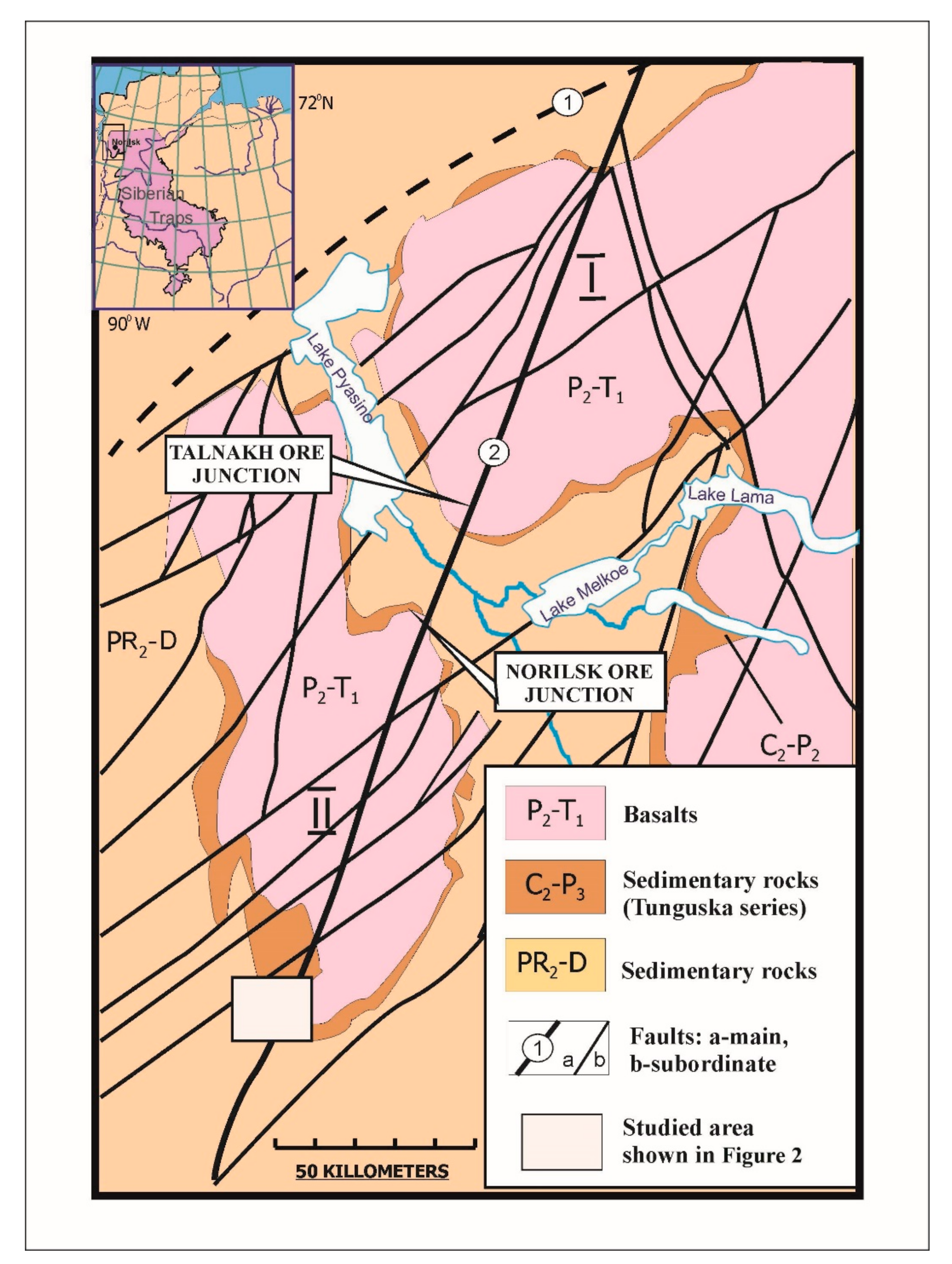
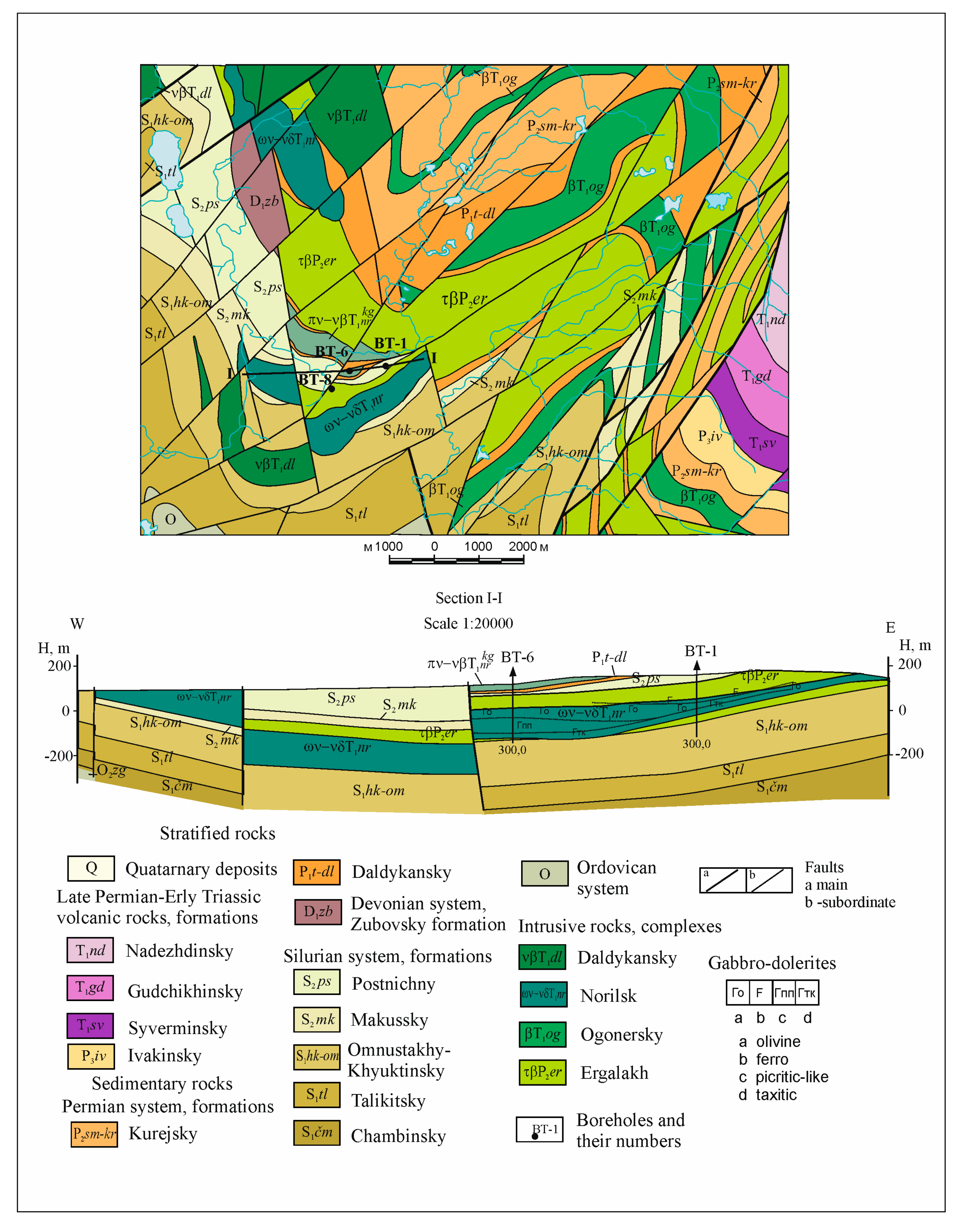
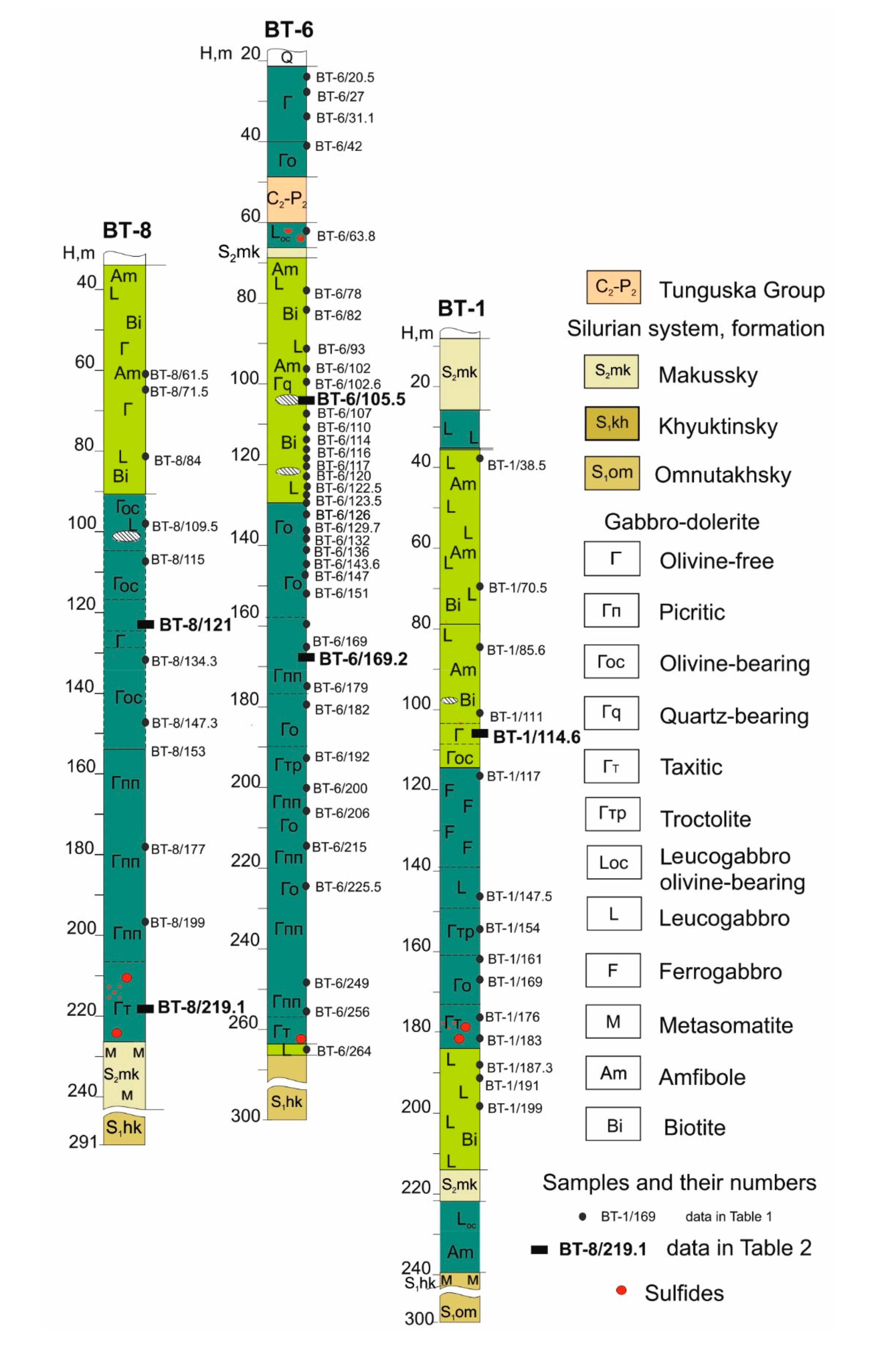
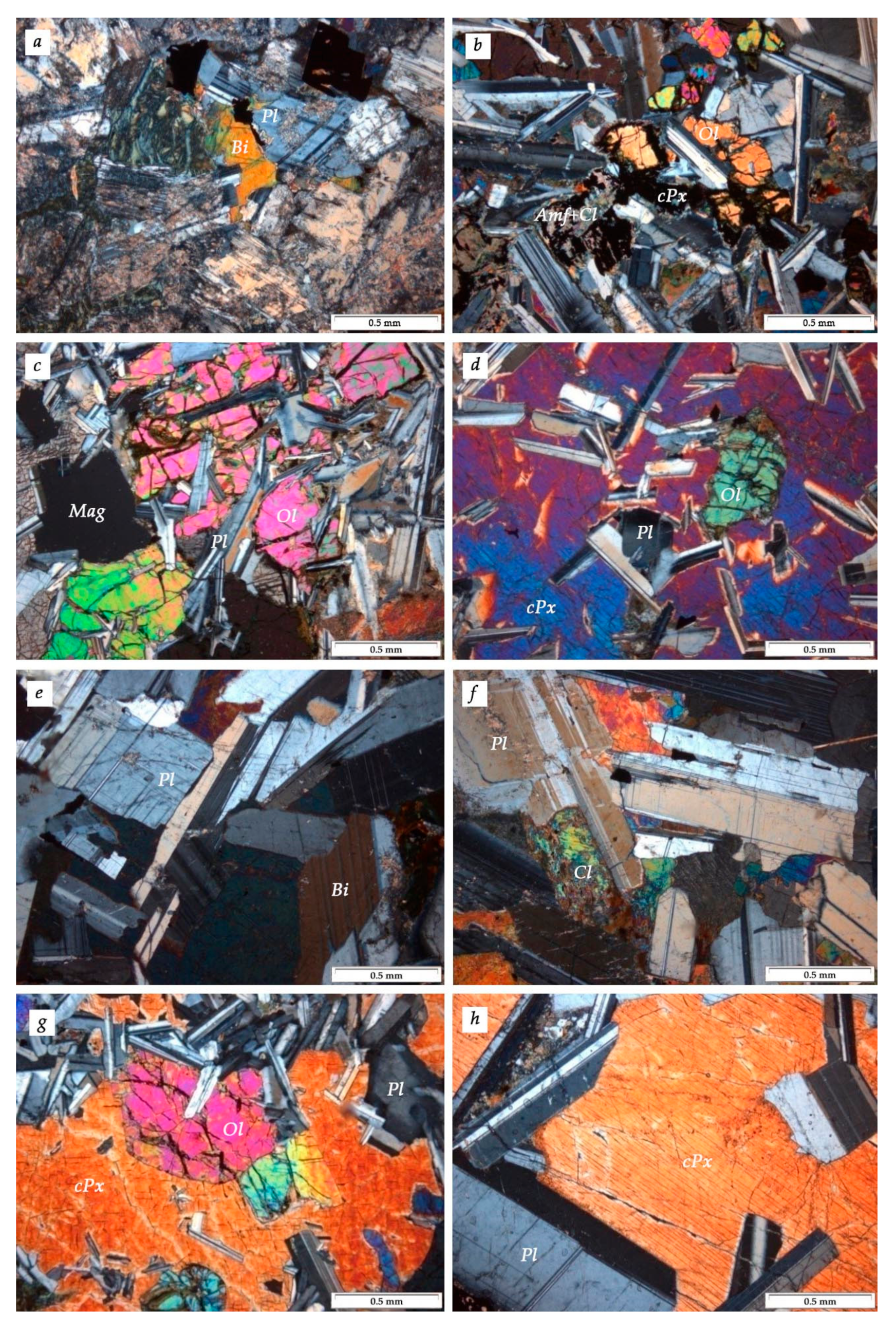
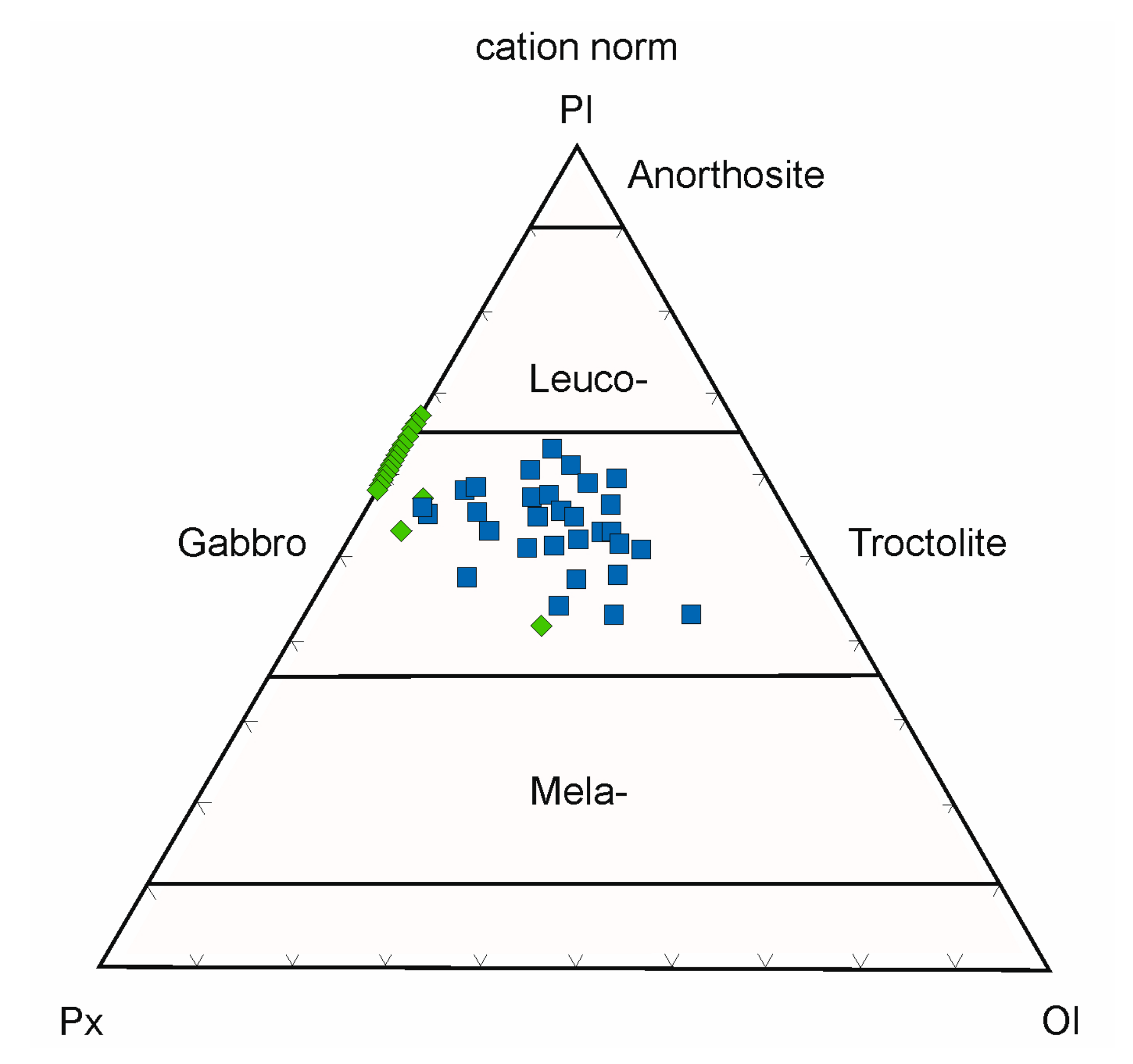

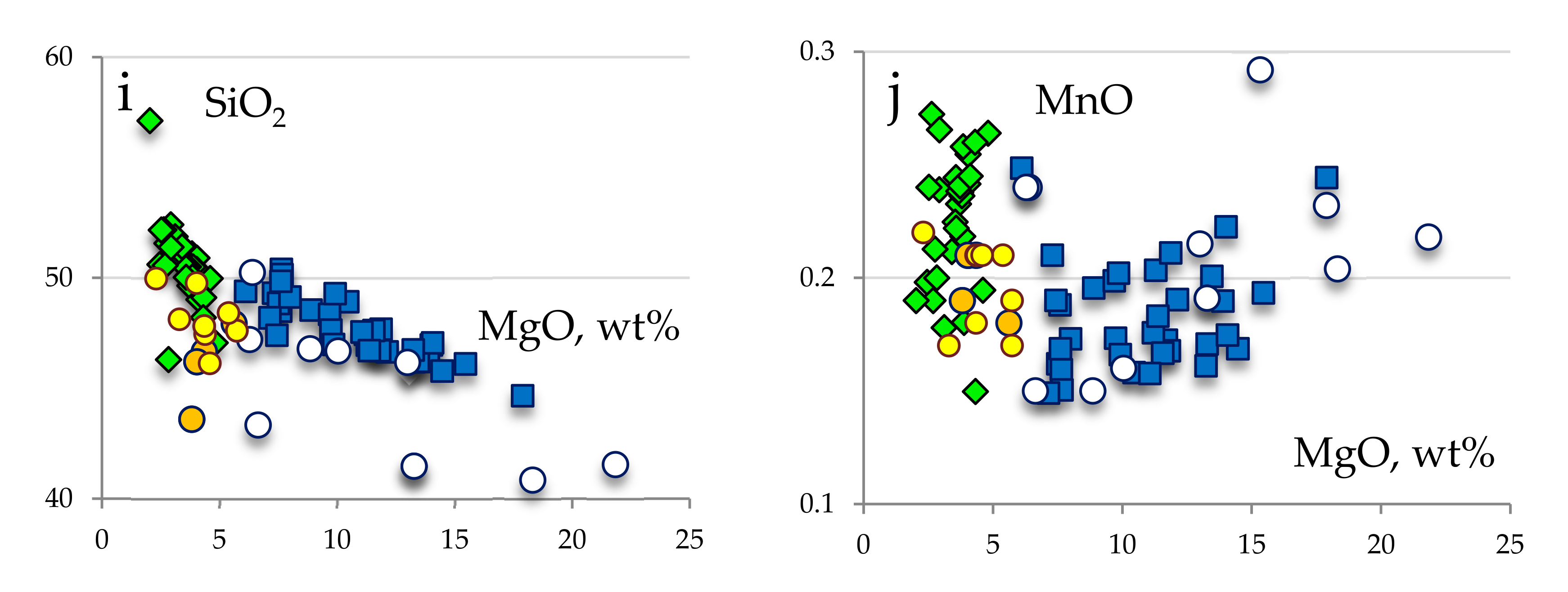
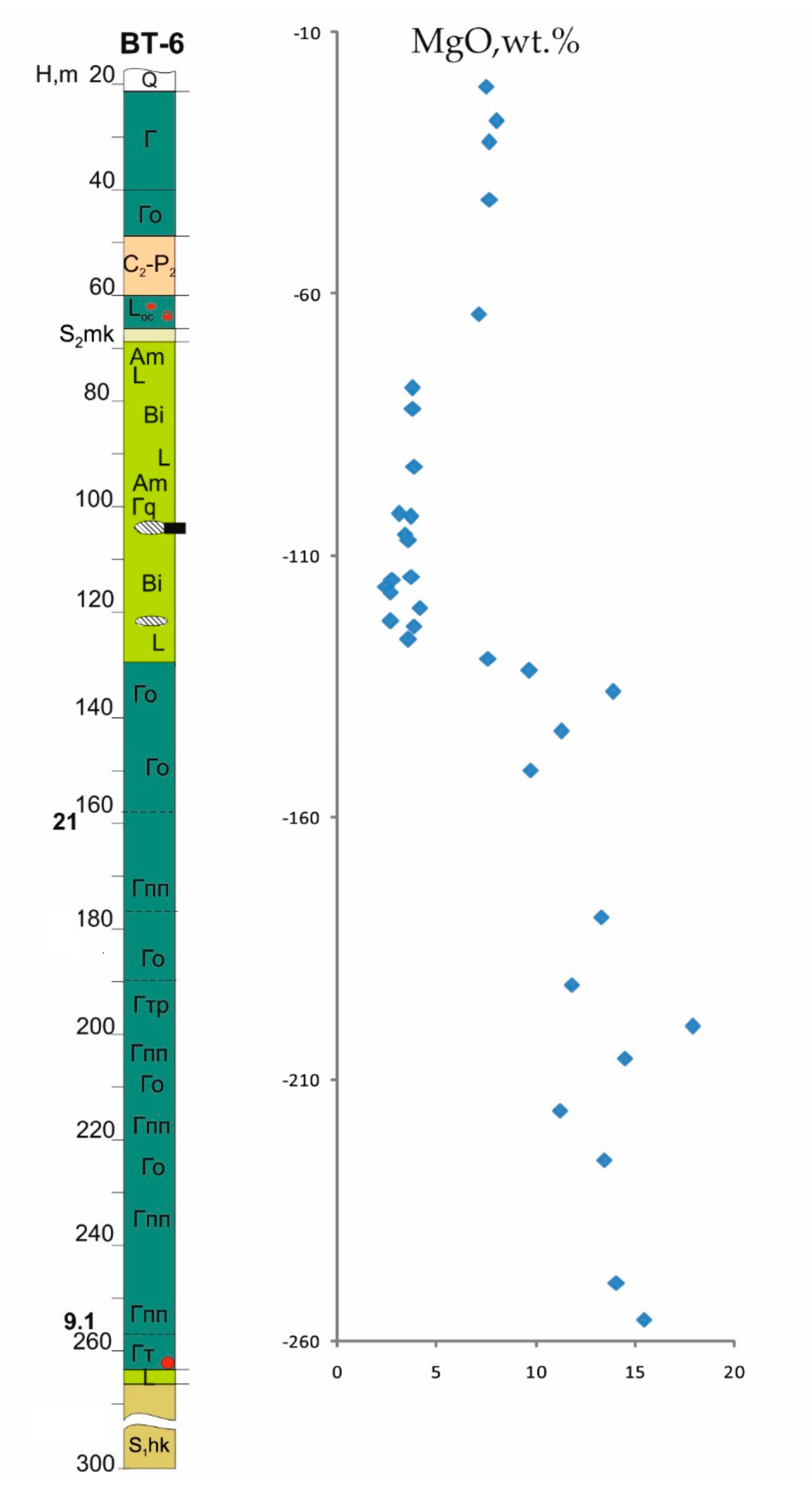
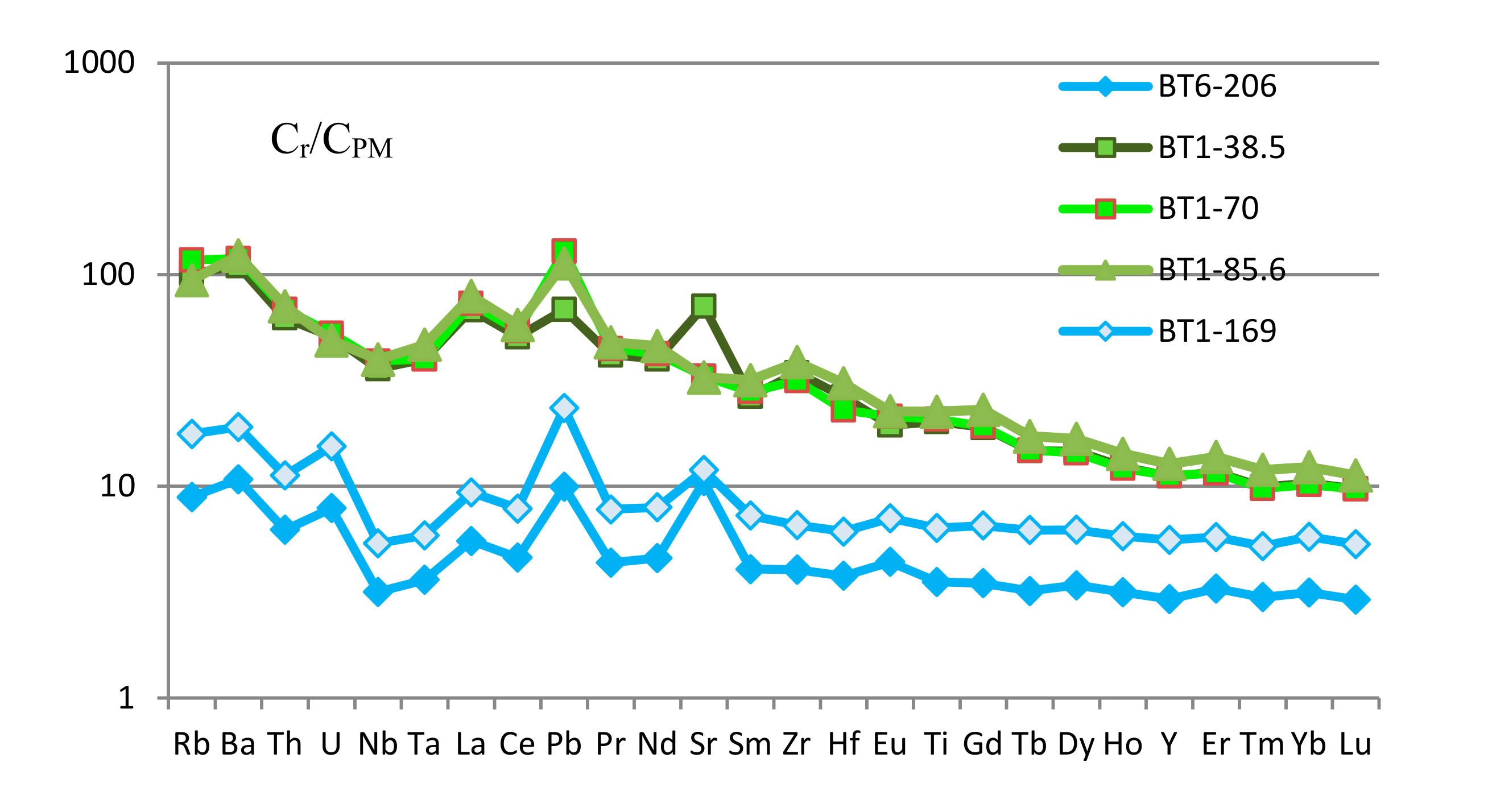
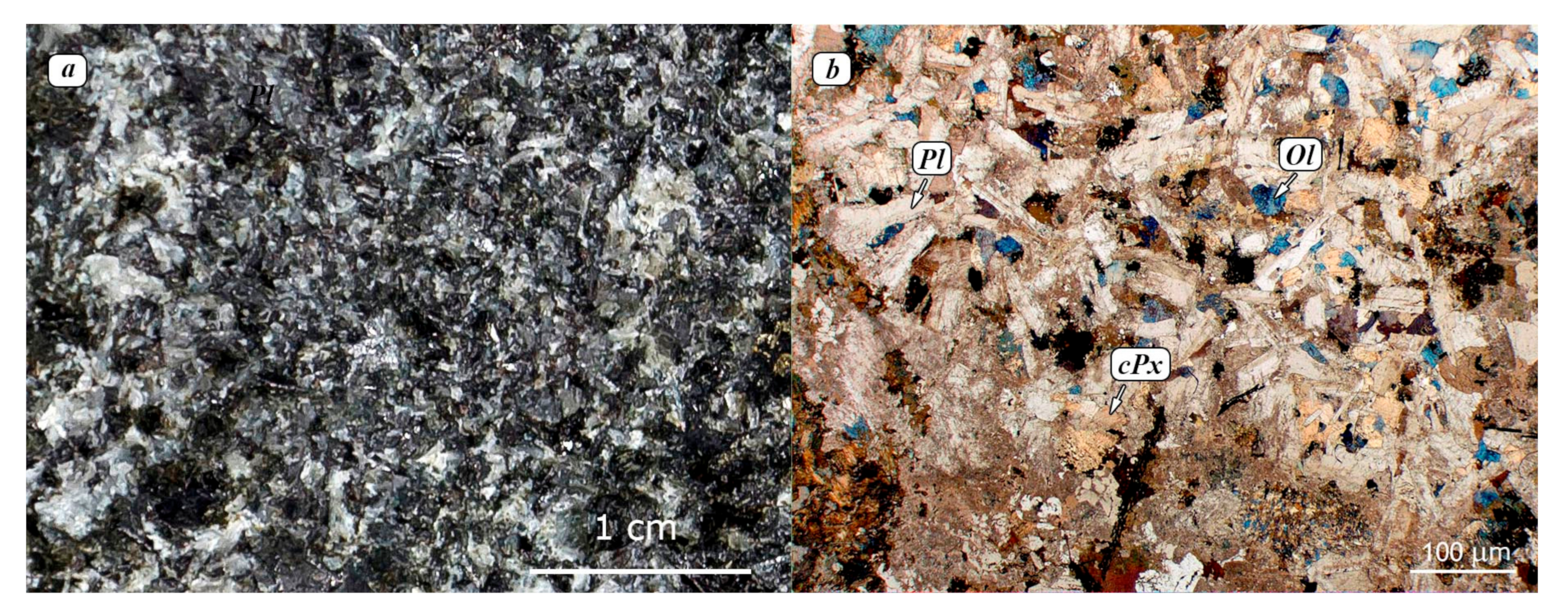
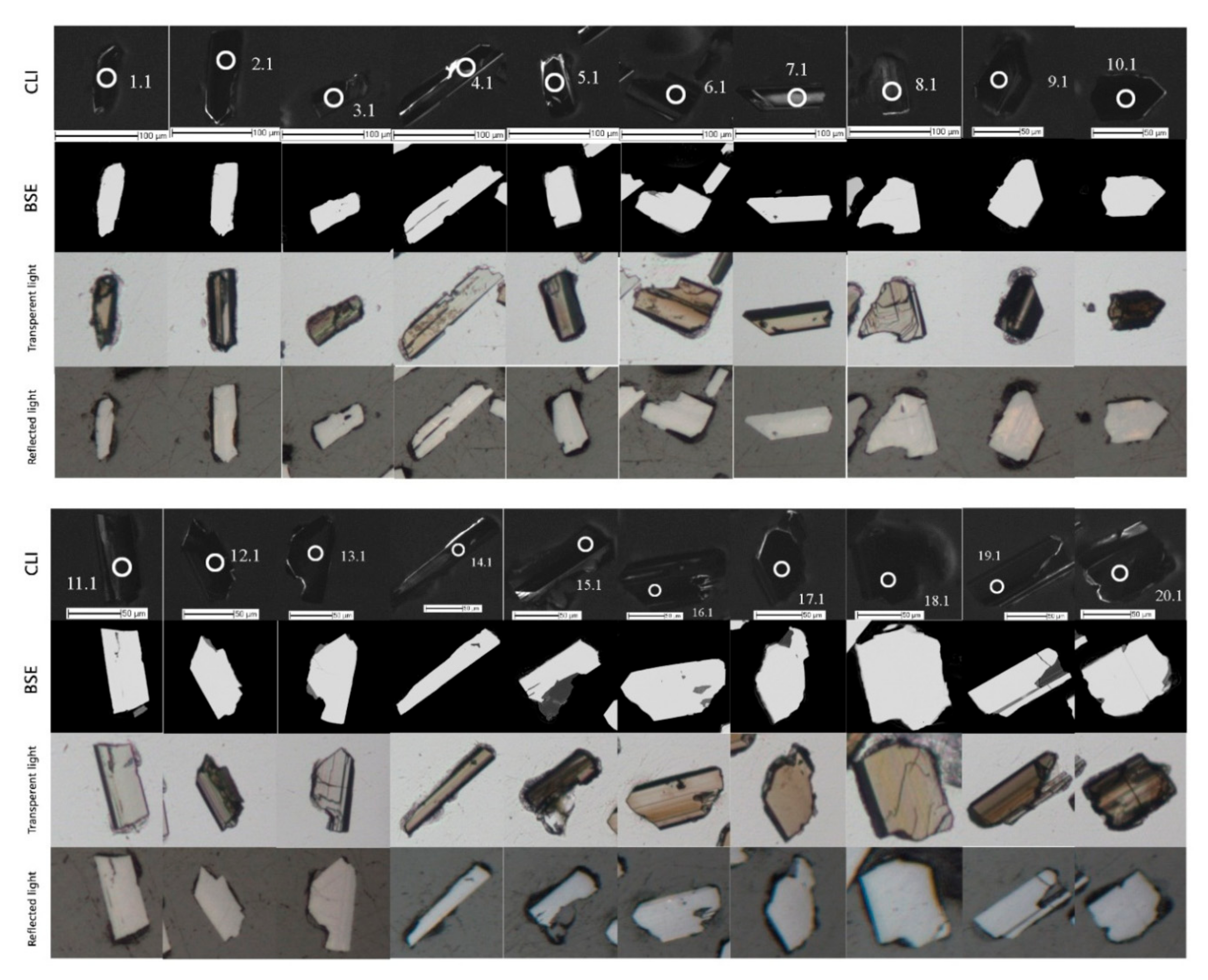
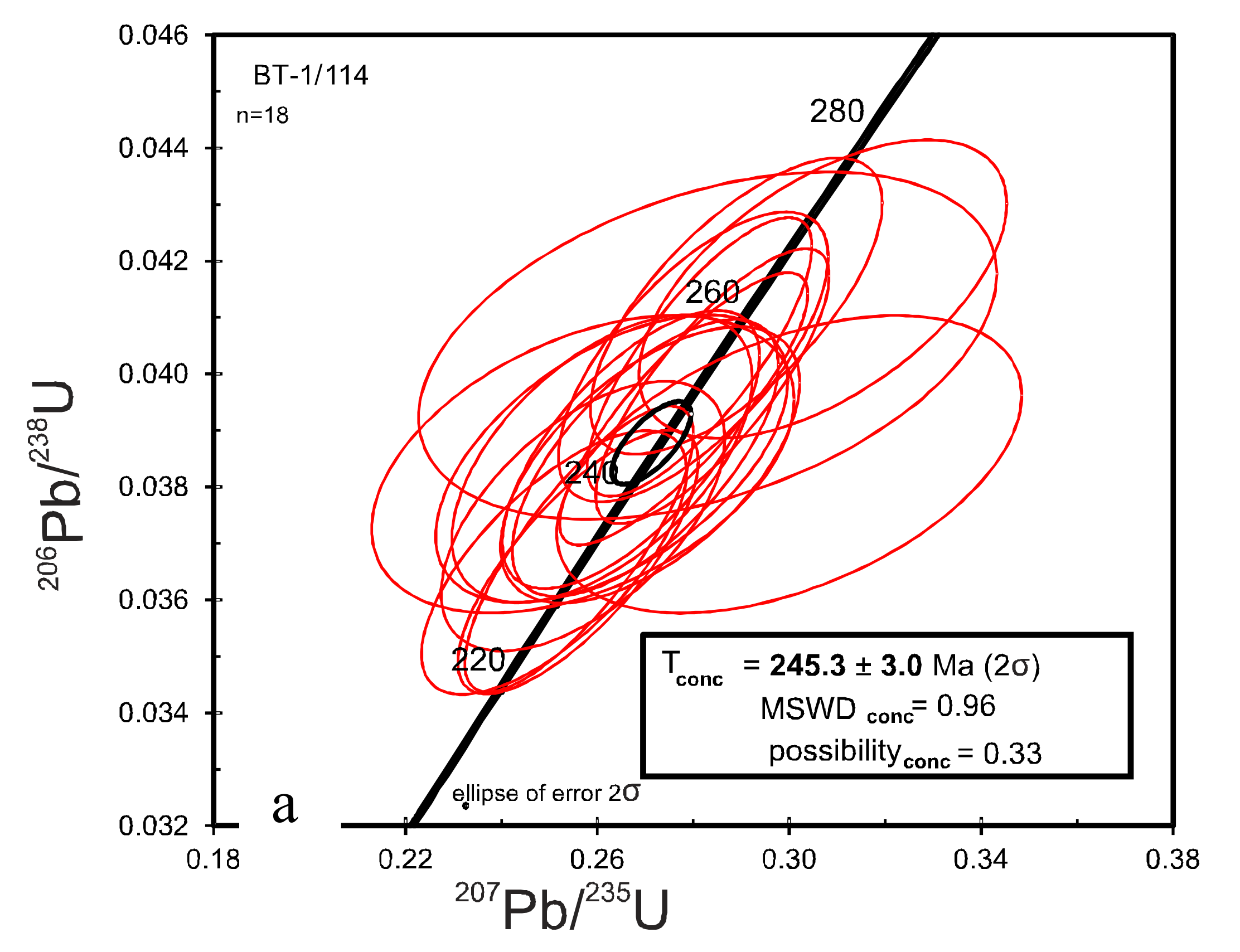
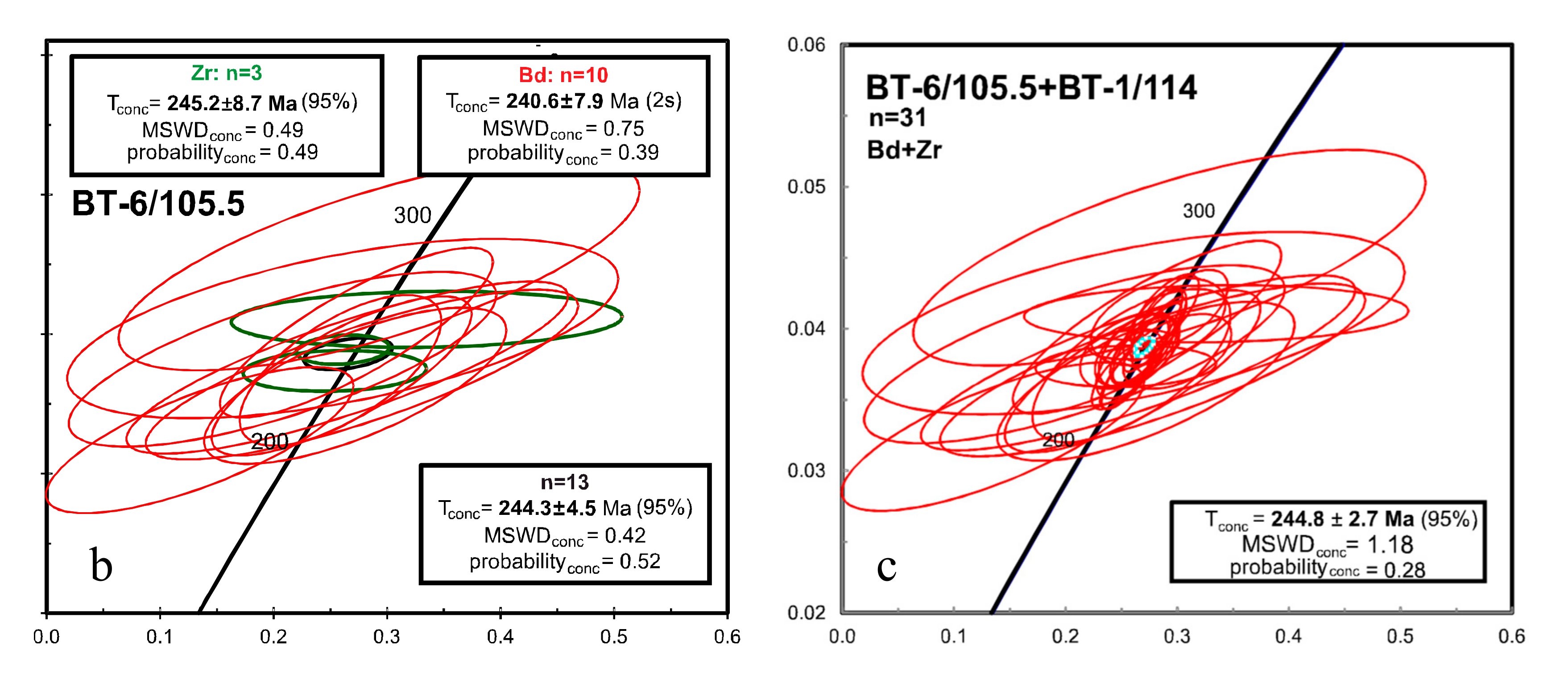
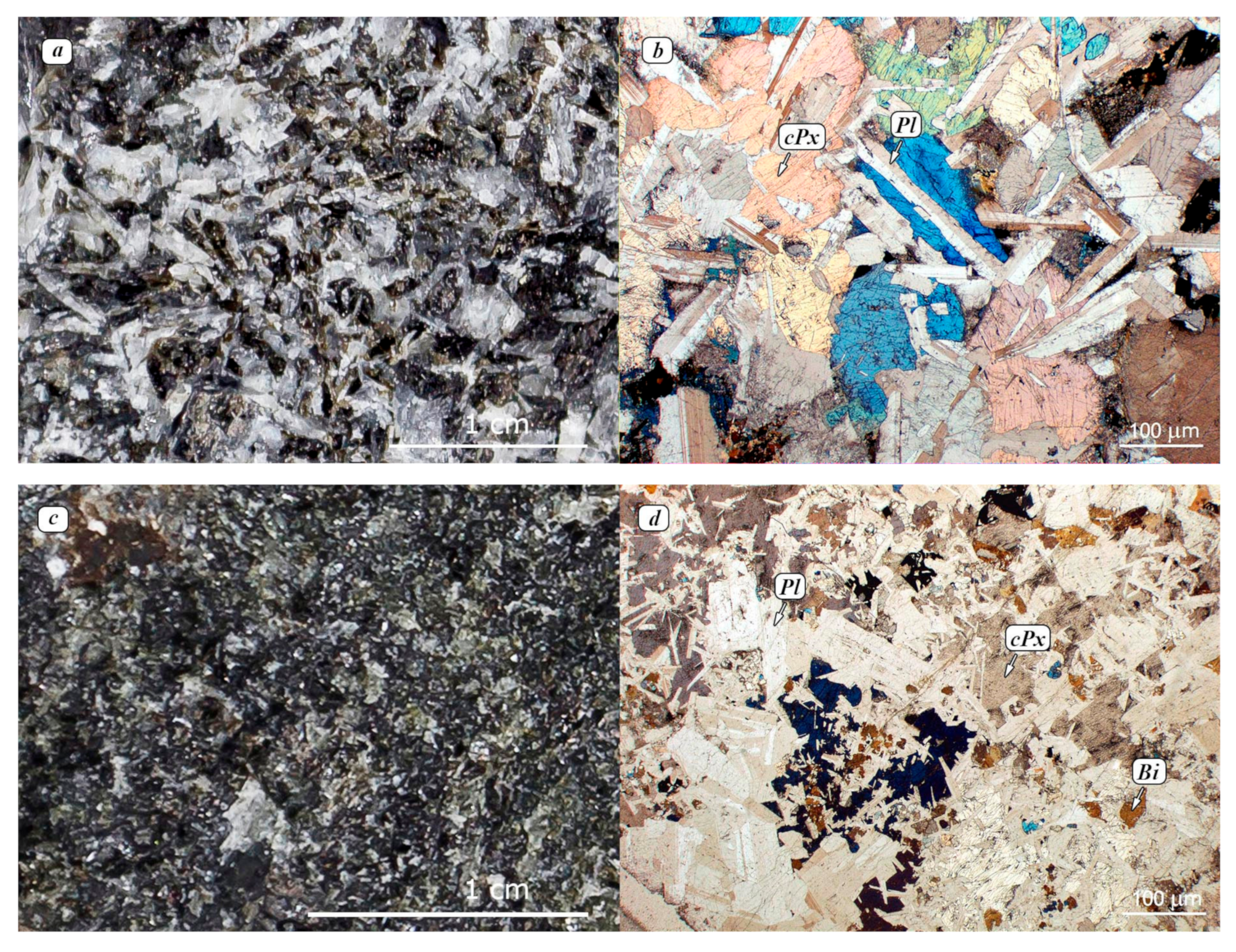

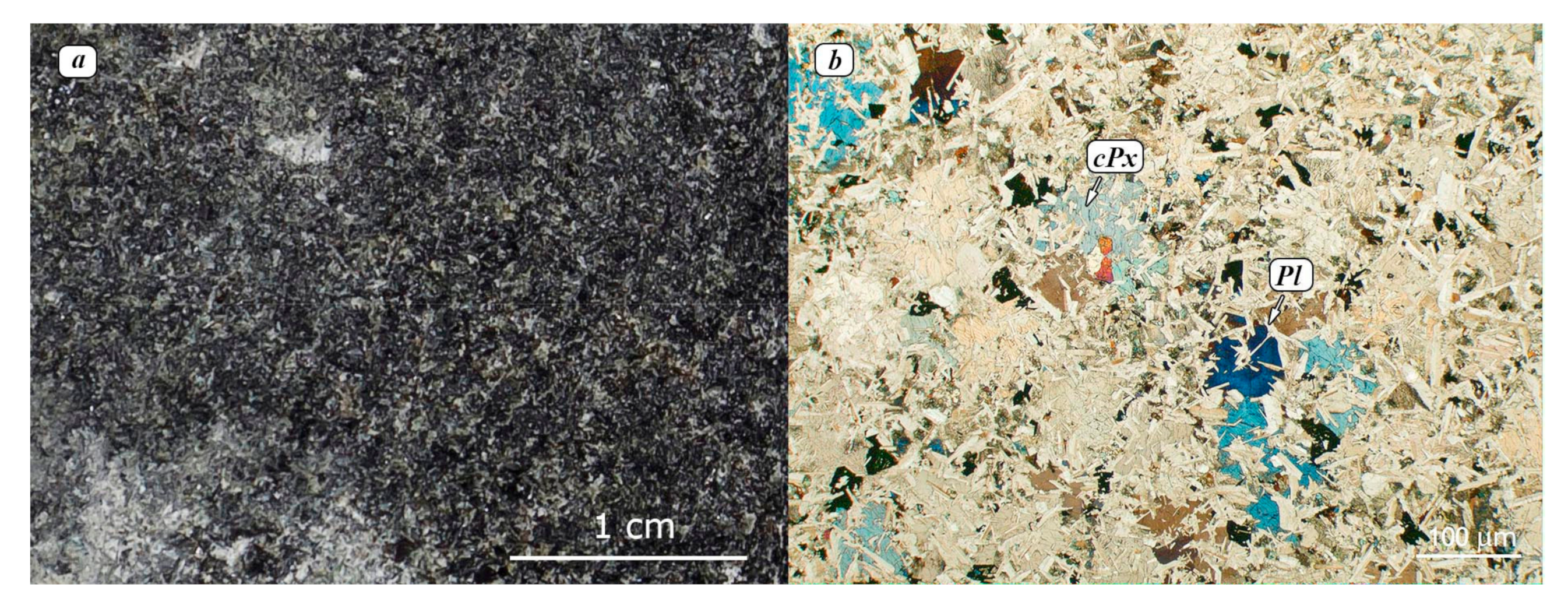

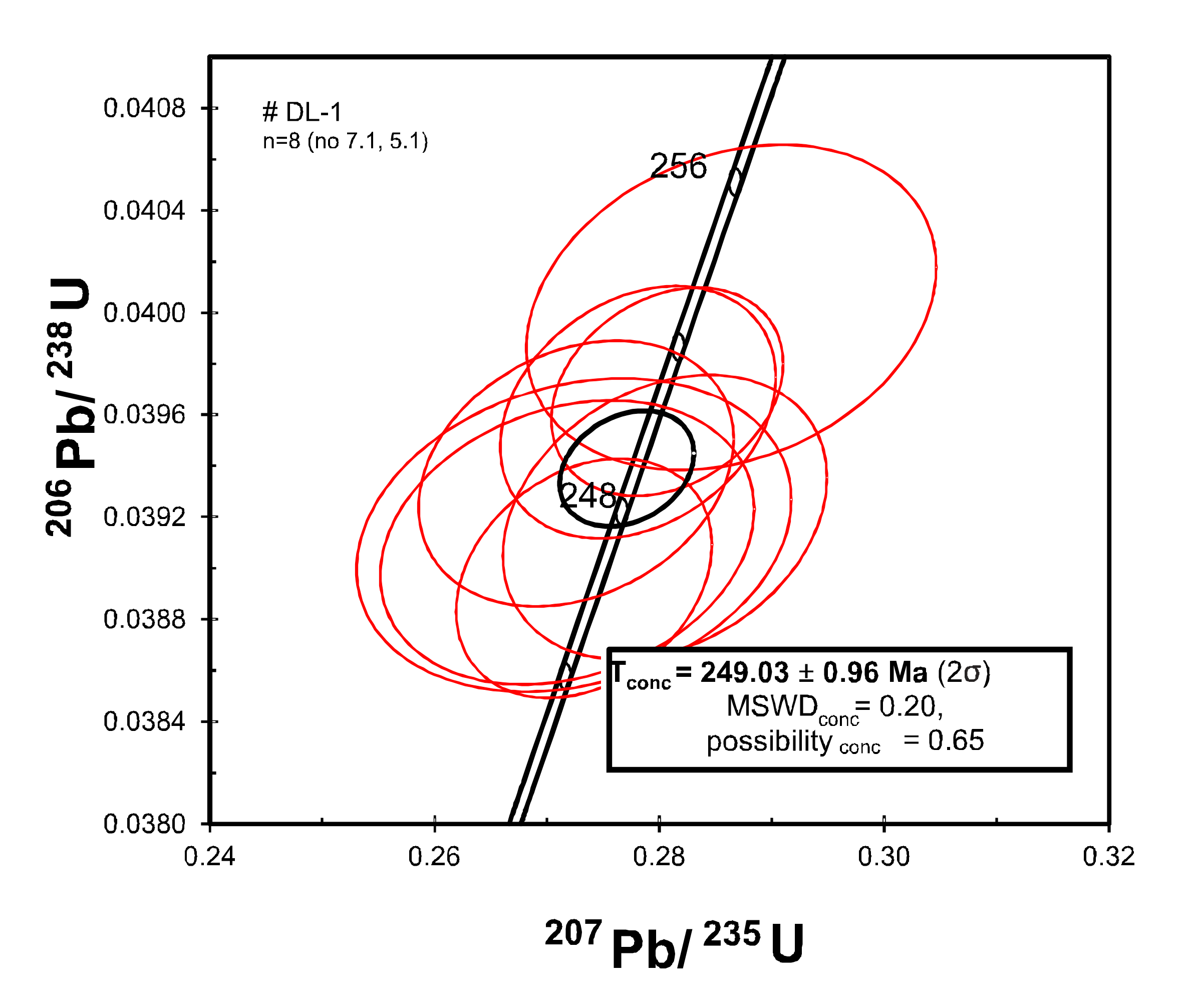
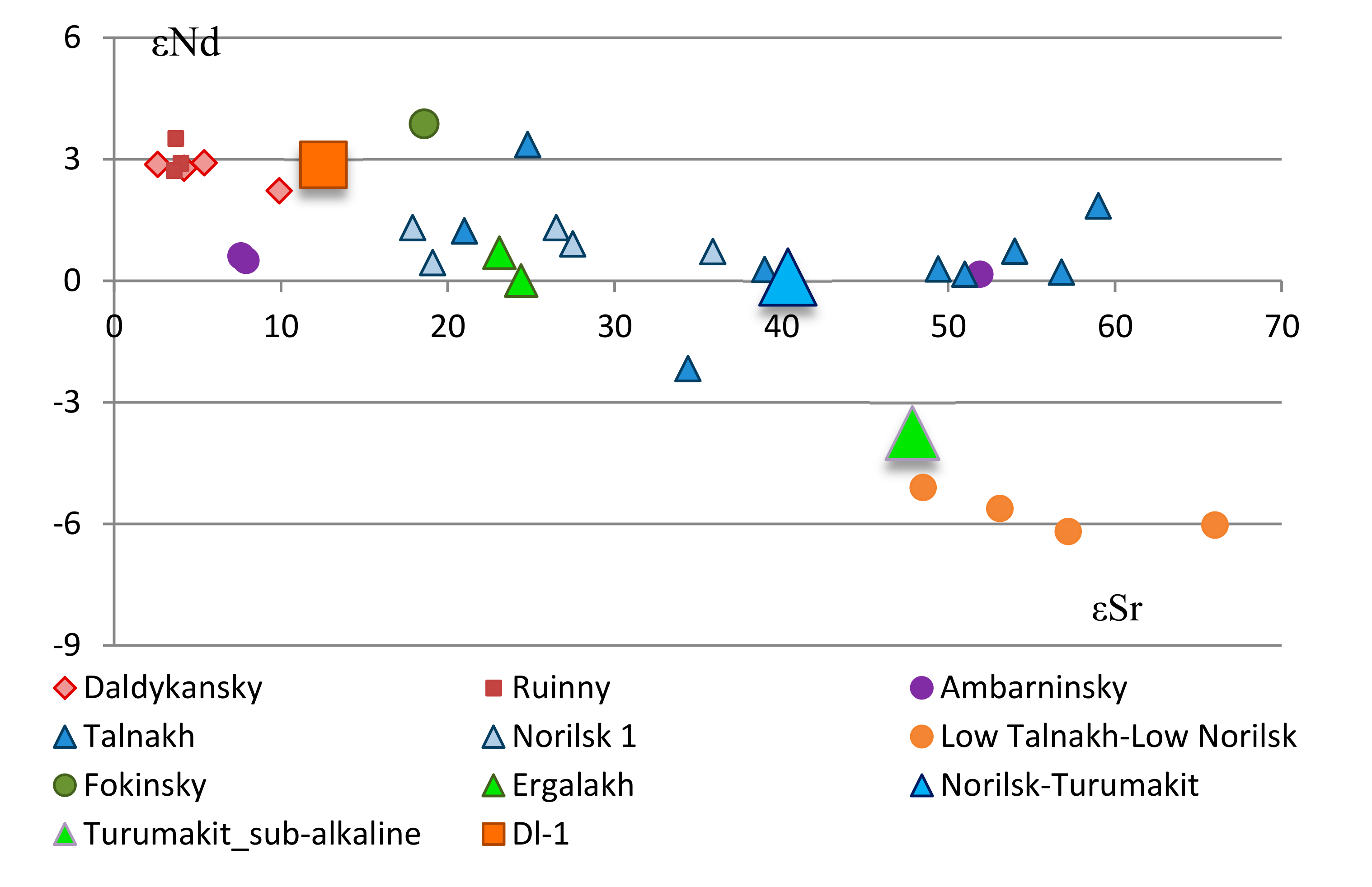

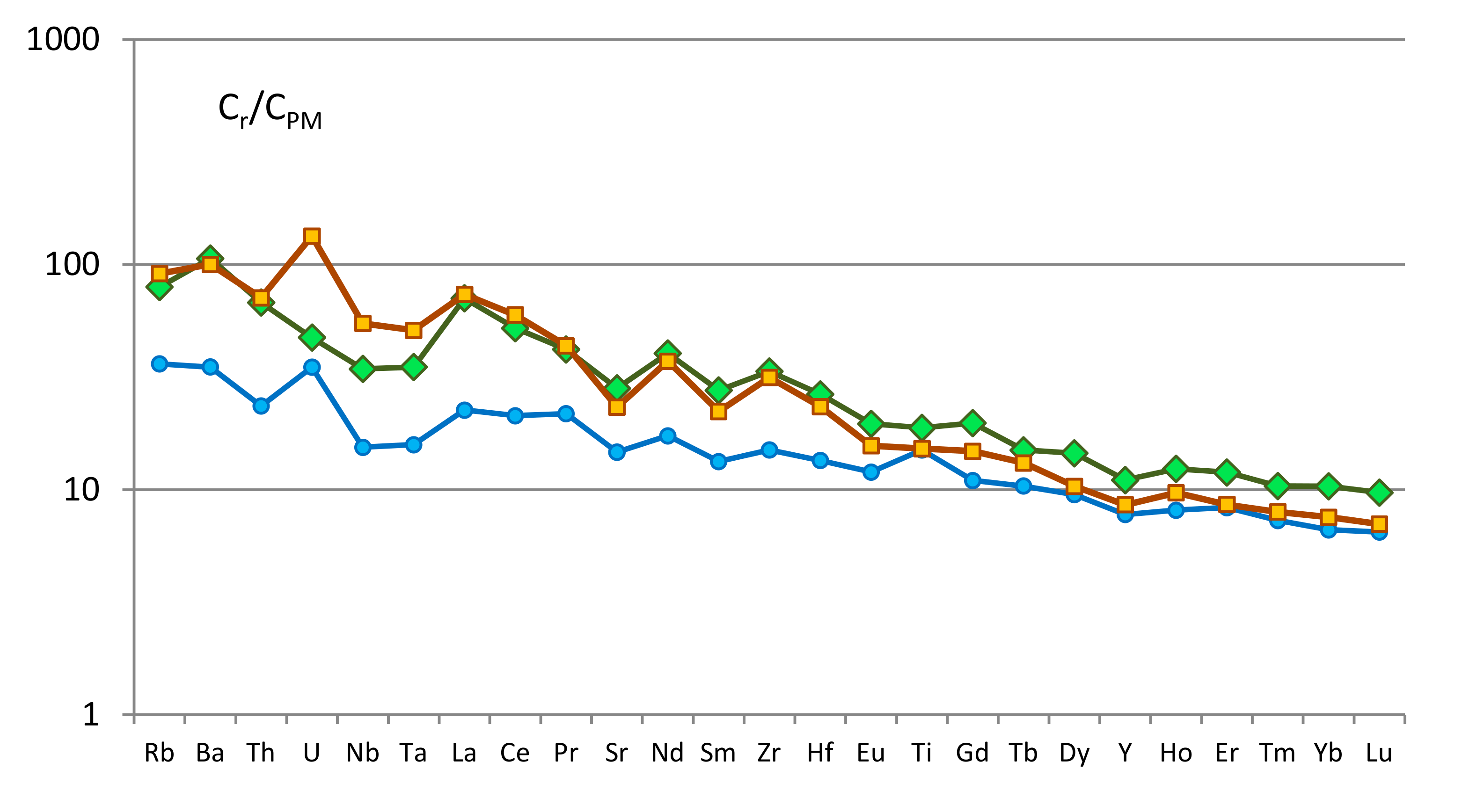
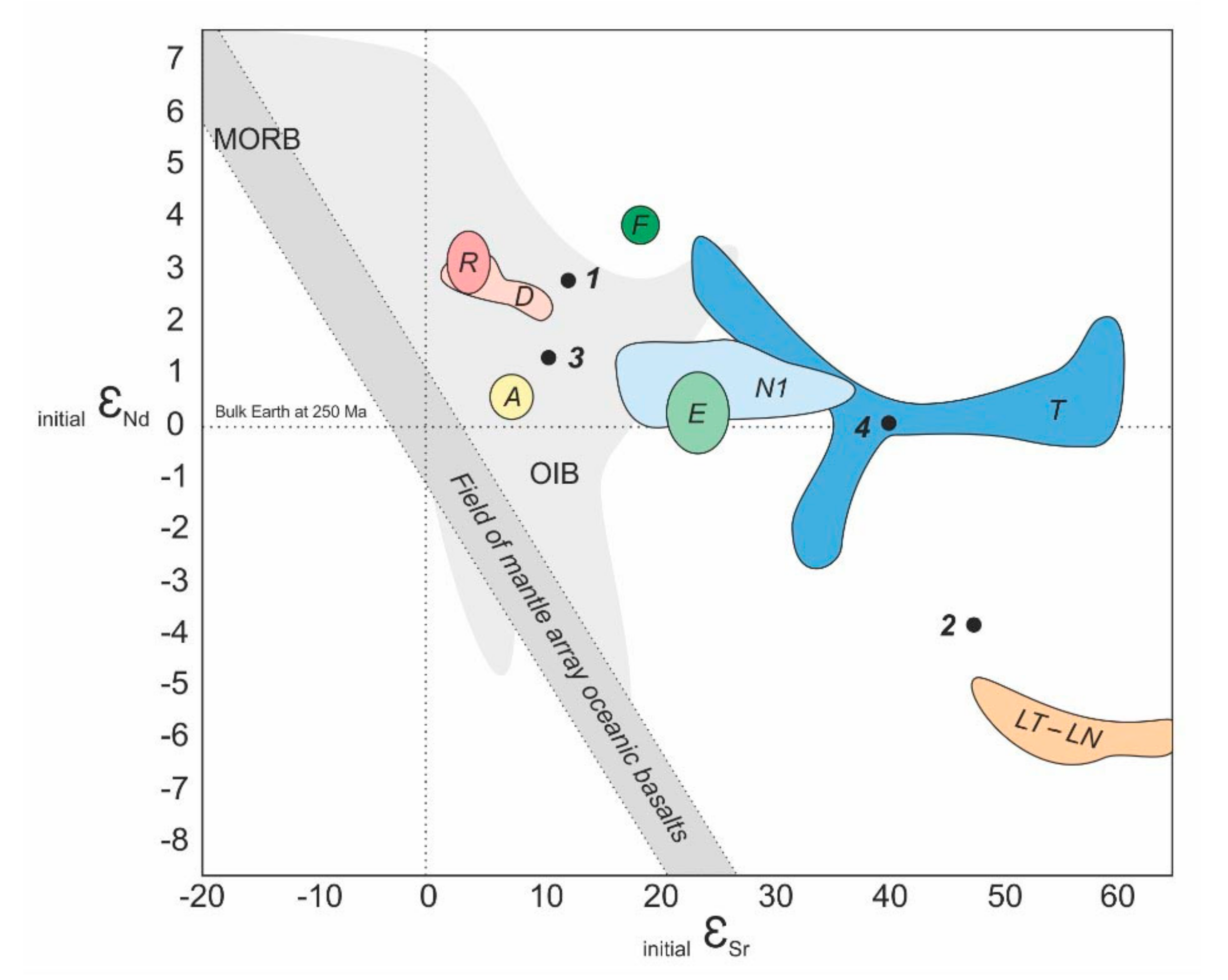
| No. | 1 | 2 | 3 | 4 | 5 | 6 |
|---|---|---|---|---|---|---|
| Sample | BT-1/114.6 | BT-6/105.5 | BT-8/121.9 | BT-8/219.1 | BT-6/169.2 | Dl-1 |
| Complex | er | er | nr | nr | nr | dl |
| SiO2 | 46.3 | 48.2 | 49.3 | 47.4 | 46.70 | 45.7 |
| TiO2 | 3.33 | 4.7 | 2.13 | 1.49 | 0.71 | 2.02 |
| Al2O3 | 13.4 | 11.7 | 13.1 | 16.5 | 16.56 | 15.3 |
| Fe2O3 | 16.3 | 17.8 | 11.8 | 12.6 | 11.49 | 15.6 |
| MnO | 0.2 | 0.26 | 0.21 | 0.19 | 0.18 | 0.22 |
| MgO | 2.83 | 4.31 | 7.3 | 7.44 | 11.38 | 6.53 |
| CaO | 9.16 | 8.13 | 12.9 | 11.3 | 10.35 | 10.1 |
| Na2O | 3.44 | 2.89 | 2.43 | 2.34 | 2.15 | 2.95 |
| K2O | 3.19 | 2.02 | 0.55 | 0.61 | 0.26 | 0.62 |
| P2O5 | 1.54 | 0.67 | 0.15 | 0.16 | 0.05 | 0.21 |
| LOI | 0.2 | 0.05 | 0.27 | 0.33 | 0.61. | 0.61 |
| Cr | 4.29 | 7.32 | 545 | 165 | 310 | 158 |
| Ni | 5.33 | 9.38 | 79.5 | 134 | 320 | 118 |
| Rb | 55.1 | 56.4 | 15.3 | 12.6 | 6.3 | 17.7 |
| Sr | 1010 | 555 | 215 | 433 | 194 | 238 |
| Y | 65.6 | 45.8 | 26.5 | 19.8 | 13.5 | 39.3 |
| Zr | 394 | 278 | 81.5 | 72.6 | 57.4 | 135 |
| Nb | 40.2 | 23.4 | 4.03 | 4.09 | 2,61 | 7.88 |
| Ba | 1140 | 633 | 120 | 186 | 84 | 163 |
| La | 70.5 | 40.4 | 8.05 | 7.27 | 4.83 | 11.1 |
| Ce | 153 | 88 | 18 | 16.7 | 10.3 | 26.1 |
| Pr | 19.2 | 10.9 | 2.62 | 2.21 | 1.41 | 3.62 |
| Nd | 81.3 | 46.5 | 12.2 | 9.66 | 7.32 | 17.4 |
| Sm | 17.2 | 10.5 | 3.61 | 3.03 | 2.04 | 5.04 |
| Eu | 4.64 | 3.13 | 1.13 | 1.05 | 0.78 | 1.73 |
| Gd | 17 | 10.4 | 3.98 | 2.84 | 2.74 | 6.13 |
| Tb | 2.38 | 1.55 | 0.72 | 0.53 | 1.56 | 1.04 |
| Dy | 13.4 | 8.88 | 4.53 | 3.5 | 2.72 | 6.66 |
| Ho | 2.55 | 1.68 | 0.98 | 0.75 | 0.56 | 1.41 |
| Er | 6.98 | 4.61 | 2.68 | 2.29 | 1.66 | 4.02 |
| Tm | 0.94 | 0.65 | 0.35 | 0.3 | 0.23 | 0.58 |
| Yb | 5.55 | 3.93 | 2.47 | 1.93 | 1.59 | 3.64 |
| Lu | 0.83 | 0.59 | 0.41 | 0.32 | 0.23 | 0.51 |
| Hf | 9.19 | 6.93 | 2.29 | 2.27 | 7.61 | 3.73 |
| Ta | 2.34 | 1.41 | 0.25 | 0.27 | 0.17 | 0.47 |
| Pb | 11.3 | 7.9 | 3.89 | 1.87 | 1.07 | 4.5 |
| Th | 6.36 | 4.59 | 1.11 | 1.1 | 0.68 | 1.38 |
| U | 1.83 | 1.22 | 0.42 | 0.47 | 0.20 | 0.58 |
| Sample | Rb | Sr | 87Rb/86Sr | 87Sr/86Sr ± 2σ | Sm | Nd | 147Sm/144Nd | 143Nd/144Nd ± 2σ | 206Pb/204Pb ± 2σ | 207Pb/204Pb ± 2σ | 208Pb/204Pb ± 2σ |
|---|---|---|---|---|---|---|---|---|---|---|---|
| DL-1 | 14.5 | 219 | 0.19170 | 0.705775 ± 7 | 4.81 | 16.9 | 0.17206 | 0.512744 ± 3 | 18.8406 ± 5 | 15.5896 ± 4 | 38.4779 ± 13 |
| БT-1/114.6 | 47.0 | 938 | 0.14481 | 0.708095 ± 10 | 16.4 | 76.8 | 0.12887 | 0.512334 ± 2 | 18.2812 ± 10 | 15.5356 ± 9 | 38.2412 ± 28 |
| БT-6/169.2 | 4.90 | 168 | 0.08439 | 0.705271 ± 7 | 1.84 | 6.60 | 0.16818 | 0.512661 ± 3 | 18.5325 ± 7 | 15.5807 ± 6 | 38.4754 ± 17 |
| БT-8/219.1 | 13.6 | 494 | 0.07955 | 0.707337 ± 7 | 3.44 | 12.2 | 0.17016 | 0.512599 ± 3 | 18.8393 ± 10 | 15.6203 ± 9 | 38.6435 ± 26 |
| Sample | Re, ppb | Os, ppb | 187Re/188Os | 187Os/188Os ± 2σ | Model Age, Ma |
|---|---|---|---|---|---|
| DL-1 | 0.146 | 0.106 | 6.754 | 0.1911 ± 13 | 597 |
| BT-1/114.6 | 1.468 | 0.034 | 263.0 | 1.2833 ± 44 | 264 |
| BT-8/219.1 | 0.649 | 0.336 | 9.333 | 0.2361 ± 6 | 725 |
| BT-8/121.9 | 1.006 | 0.052 | 97.93 | 0.6069 ± 5 | 294 |
© 2020 by the authors. Licensee MDPI, Basel, Switzerland. This article is an open access article distributed under the terms and conditions of the Creative Commons Attribution (CC BY) license (http://creativecommons.org/licenses/by/4.0/).
Share and Cite
Sereda, E.; Belyatsky, B.; Krivolutskaya, N. Geochemistry and Geochronology of Southern Norilsk Intrusions, SW Siberian Traps. Minerals 2020, 10, 165. https://doi.org/10.3390/min10020165
Sereda E, Belyatsky B, Krivolutskaya N. Geochemistry and Geochronology of Southern Norilsk Intrusions, SW Siberian Traps. Minerals. 2020; 10(2):165. https://doi.org/10.3390/min10020165
Chicago/Turabian StyleSereda, Elena, Boris Belyatsky, and Nadezhda Krivolutskaya. 2020. "Geochemistry and Geochronology of Southern Norilsk Intrusions, SW Siberian Traps" Minerals 10, no. 2: 165. https://doi.org/10.3390/min10020165
APA StyleSereda, E., Belyatsky, B., & Krivolutskaya, N. (2020). Geochemistry and Geochronology of Southern Norilsk Intrusions, SW Siberian Traps. Minerals, 10(2), 165. https://doi.org/10.3390/min10020165






